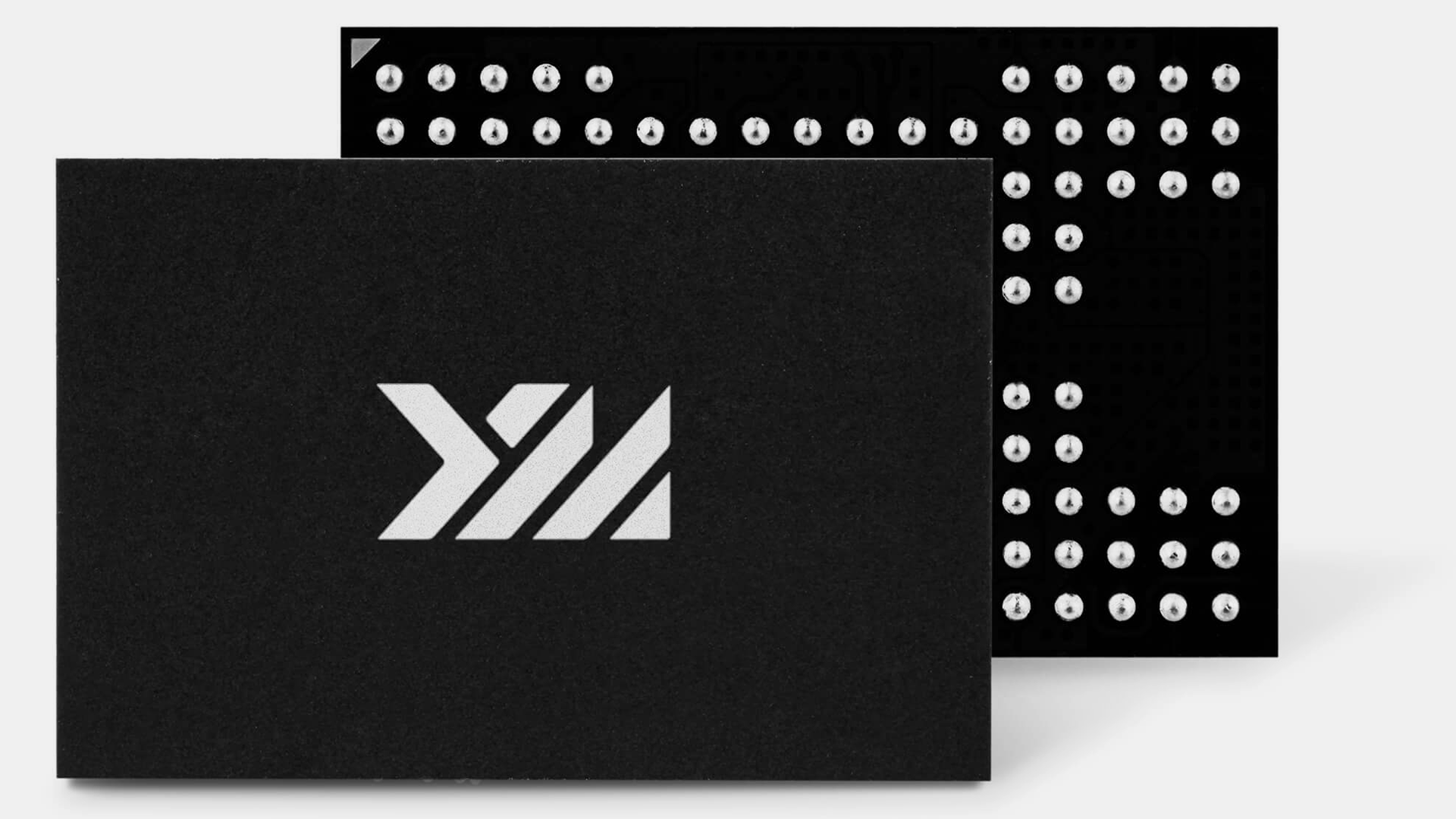China's YMTC moves to break free of U.S. sanctions by building production line with homegrown tools — aims to capture 15% of NAND market by late 2026

Yangtze Memory Technologies Co. (YMTC), China's leading producer of NAND memory, has been on the Entity List of the U.S. Commerce Department since late 2022, which essentially bars its access to advanced fab tools. Despite sanctions and restrictions, YMTC plans to expand its production capacity this year, aiming to capture a 15% share of NAND memory production by the end of 2026, reports DigiTimes. The company also plans to build a trial production line that exclusively uses Chinese fab tools.
YMTC to expand capacity to 150,000 wafer starts per month
YMTC was expected to reach a monthly capacity of 130,000 wafer starts per month (WSPM) by the end of 2024, which equates to roughly 8% of the worldwide NAND supply, according to DigiTimes. While YMTC's abilities to procure fab tools from leading producers, such as ASML, Applied Materials, KLA, and LAM Research are extremely limited, the company still plans to increase its production capacity to around 150,000 WSPM. Earlier this year, the company began mass production of its X4-9070 3D TLC NAND memory, featuring 232 active layers and a total of 294 active layers. The company's 5th Generation NAND memory bonds two structures containing 150 and 144 layers together to achieve a total of 294 layers.
The increased output, combined with the increased number of layers (or gates per vertical NAND string), effectively increases NAND memory bit output for YMTC. However, it remains to be seen whether such a strategy can enable the company to double its market share and achieve 15% of the global NAND output by late 2026.
Unlike other global NAND suppliers, who are cutting production and investment due to soft demand and pricing pressure, YMTC continues to expand. Bit growth across the industry is forecast to rise by about 10% to 15% in 2025, but YMTC is expected to ramp up its bit growth aggressively.
In addition to its flagship 1TB 3D TLC X4-9070 device with a 3600 MT/s interface, the company intends to release its 3D QLC X4-6080 device later this year. We do not know how many active layers this device will use, though it is more than likely that it will retain the 294-layer production technology.
Next year, the company will introduce its 2TB 3D TLC X5-9080 device, as well as a 3D QLC X5-6080 device with a 4800 MT/s interface. The 2TB NAND device will enable YMTC to build high-capacity SSDs with very high performance. Though it remains to be seen whether the company can produce enough of these particular chips.
YMTC's next-generation node will likely use more than 300 layers and will likely require the company to bond three 3D NAND structures together. This means that wafers will spend more time in the fab, therefore reducing the number of wafer starts per month, but increasing bit output.
A new hope?
Under the export rules imposed in late 2022, American companies cannot ship tools that can be used to make 3D NAND memory with over 128 layers to Chinese entities. Of course, the U.S. government cannot ban the usage of string stacking (the technology used by YMTC to build its 232L 3D NAND), so YMTC can continue scaling its 3D NAND using American tools. However, the U.S. Department of Commerce put YMTC into its Entity List in December 2022, which means that American companies should get an export license from the Department of Commerce to sell tools to the Chinese company.
We do not know whether or not YMTC managed to acquire any new American tools after 2022, but the NAND flash producer plans to begin trial production on a new manufacturing line built entirely with domestically developed equipment in the second half of 2025, according to DigiTimes.
This marks a major step forward in China's goal to reduce reliance on foreign semiconductor production tools. However, a 100% localization of fab tools is well beyond what analysts may think is possible for Chinese chipmakers today.
Looking ahead, YMTC is expected to account for approximately 30% of China’s NAND consumption in 2025, but its output still falls short of national demand. The upcoming trial line is expected to help YMTC ease output constraints, even though yield levels are a major concern, due to Chinese tools being known for lower yields when compared to their American, Japanese, or European counterparts.
Analysts believe YMTC's new production line, which exclusively uses Chinese fab tools, could lead to a doubling of YMTC's bit output by the end of 2026, potentially pushing its share of the global NAND market beyond 15%.
However, these predictions may be too optimistic, as the new production line will be a trial intended to test the capabilities of tools made in China, not to produce 3D NAND devices in high volume.
If YMTC's trial production line results end up being promising, it could scale it to build flash memory chips at volume. However, scaling up will require a lot of time, so YMTC's aspirations of capturing 15% of the NAND market by late 2026 remain optimistic. It is believed that if YMTC's production capacity exceeds 200,000 WSPM, this could also influence global pricing trends.
YMTC already leads transition to domestic tools
YMTC stands out as the clear leader in China's semiconductor equipment localization efforts, with an adoption rate of 45%, far exceeding both the national average and other major domestic fabs, according to estimates from Morgan Stanley. This aggressive push aligns with its strategic goal of building fully self-reliant NAND production lines amid tightening U.S. export controls. However, a 45% adoption rate is considerably lower than 100%.
Among YMTC's domestic suppliers are AMEC (etching tools, chemical vapor deposition tools), Naura Technology (etching tools, CVD tools), and Piotech (atomic layer deposition tools, CVD tools). While Chinese companies are known for world-class etching and deposition tools, it is unclear whether YMTC can source lithography tools that it needs from local suppliers.
For now, the best Chinese lithography tool is currently produced in high volume by Shanghai Microelectronics Equipment (SMEE). The SSX600 from SMEE can make logic chips on a 90nm process technology, though it is working on more advanced tools.
Other major Chinese chipmakers are progressing with equipment localization more cautiously, and at a significantly lower pace compared to YMTC. SMIC, China's largest foundry, shows a 22% localization rate at its Jingcheng fab, and 18% at its Lingang fab. These results reflect the gradual substitution of foreign tools, likely limited by reliance on advanced lithography systems that China cannot yet produce domestically.
Hua Hong (Fab 9) and CXMT, a DRAM manufacturer, both report 20% localization, signaling steady but conservative integration of domestic equipment, especially in mature-node manufacturing where localization is more feasible.
YMTC's investment arm, Changjiang Capital, has quietly funded a number of local tool and material suppliers, specifically those tied to its own production network. To avoid attracting unwanted attention from U.S. authorities, these investments are often routed through non-listed or indirect entities. Suppliers have also reportedly been instructed to strip their badges from equipment.
While Chinese chipmakers are making incremental progress, their localization levels remain clustered in the 15% – 27% range — well below YMTC's 45% — highlighting the complexity of replacing foreign wafer fab equipment. That said, YMTC's plan to localize 100% of their tools looks unrealistic for now, despite their lofty goals.
Follow Tom's Hardware on Google News to get our up-to-date news, analysis, and reviews in your feeds. Make sure to click the Follow button.

Anton Shilov is a contributing writer at Tom’s Hardware. Over the past couple of decades, he has covered everything from CPUs and GPUs to supercomputers and from modern process technologies and latest fab tools to high-tech industry trends.
-
IBM296 Hmm 2026 is going to be an interesting year for semiconductor manufacturing. Huawei is rumored to produce their EUV machines, YMTC is pushing for increased global market NAND share... Intel and Samsung's 2nm manufacturing dreams have fallen flat on their face and been pushed back to 2029.Reply
TSMC remains the global leader in semiconductor manufacturing no doubt. -
phead128 Reply
You make it seem like copying homework. If it's so easy, then why is Intel flopping so hard, just copy IP?daeros said:“Homegrown tooling” = stolen IP. -
daeros Replyphead128 said:You make it seem like copying homework. If it's so easy, then why is Intel flopping so hard, just copy IP?
Because Intel operates in countries that have and care about IP laws? I’d bet whatever tech YTMC has was overwhelmingly sourced from industrial espionage, back-engineered from machines on the ground, or even just improperly shared. But you don’t just spin up a modern semiconductor line from nothing. -
phead128 Reply
YMTC leapfrogged Samsung to produce a 232-layer NAND flash in late 2024, if you think that is based off "copying IP", then you are outdated and misinformed. You can't make giant gains and achieve basic parity like this simply by copying others.daeros said:Because Intel operates in countries that have and care about IP laws? I’d bet whatever tech YTMC has was overwhelmingly sourced from industrial espionage, back-engineered from machines on the ground, or even just improperly shared. But you don’t just spin up a modern semiconductor line from nothing. -
Mr Majestyk I find it hilarious to see the actual effect the chip sanctions by USA on China have had in lighting a fire under China's own semiconductor industry. The more the US tries to smash China, the worse it will get for them in the future.Reply -
hush now Reply
the US has never invented anything useful in modern history. literally everything the US has claimed to have invented came from the minds and innovations of immigrants and people living abroad who simply shared their information free of charge to the US. did the US invent arithmetic, paper, gun powder, the compass, and the printing press? No, but China did. has the US every paid China trillions for building things on the foundations of Chinese IP? Also no. sit down please and learn some history.daeros said:“Homegrown tooling” = stolen IP.
